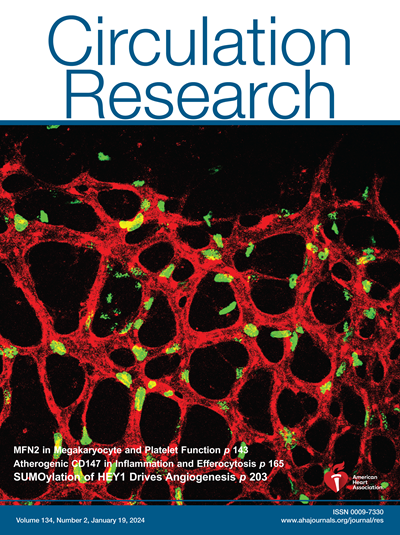DWORF Gene Therapy Improves Cardiac Calcium Handling and Mitochondrial Function.
IF 16.2
1区 医学
Q1 CARDIAC & CARDIOVASCULAR SYSTEMS
引用次数: 0
Abstract
BACKGROUND Calcium (Ca2+) dysregulation is a hallmark of heart failure, impairing excitation-contraction coupling and contributing to pathological remodeling. The SERCA2a (sarco/endoplasmic reticulum Ca2+ ATPase isoform 2a) mediates Ca2+ reuptake into the sarcoplasmic reticulum (SR) during diastole, but its activity declines in failing hearts. DWORF (dwarf open reading frame), a newly identified cardiac microprotein, enhances SERCA2a activity and improves cardiomyocyte Ca2+ cycling and contractility. SR Ca2+ release also influences mitochondrial metabolism and ATP production. Here, we investigated whether DWORF overexpression improves SR Ca2+ handling, augments mitochondrial Ca2+ signaling, and protects against heart failure progression. METHODS Transgenic and adeno-associated virus approaches were used to overexpress DWORF in the heart. Mice underwent transverse aortic constriction to model pressure overload-induced heart failure. Cardiac function, mitochondrial metabolism, SR Ca2+ uptake, and remodeling were assessed. RESULTS Mitochondria from DWORF transgenic hearts displayed increased basal respiration, maximal respiration, and spare respiratory capacity, correlating with enhanced mitochondrial Ca2+ uptake kinetics. Western blot analysis showed elevated levels of active PDH (pyruvate dehydrogenase) and mitochondrial Ca2+ uniporter expression in DWORF transgenic hearts, supporting a role for DWORF in Ca2+-driven metabolic regulation. Similarly, MyoAAV-mediated DWORF overexpression enhanced mitochondrial respiration and increased levels of active PDH in adult mice. Following TAC, MyoAAV-DWORF-treated mice maintained higher left ventricular function and were protected from further deterioration compared with controls. This benefit was observed when DWORF gene therapy was delivered preventively at the time of pressure overload or after heart failure was already established. DWORF gene therapy also attenuated remodeling, with lower heart weight and lung weight-to-tibia length ratios. Seahorse analysis confirmed sustained mitochondrial improvements in both treatment paradigms. CONCLUSIONS DWORF overexpression enhances SR Ca2+ dynamics, improves mitochondrial energetics, and attenuates pathological remodeling and heart failure progression in response to pressure overload. These findings support DWORF as a promising therapeutic target for heart failure.DWORF基因治疗改善心脏钙处理和线粒体功能。
背景钙(Ca2+)失调是心力衰竭的一个标志,它会损害兴奋-收缩耦合并导致病理性重构。SERCA2a (sarco/内质网Ca2+ atp酶异构体2a)在舒张期介导Ca2+再摄取到肌浆网(SR),但其活性在衰竭心脏中下降。DWORF (dwarf open reading frame)是一种新发现的心脏微蛋白,可增强SERCA2a活性,改善心肌细胞Ca2+循环和收缩性。SR Ca2+释放也影响线粒体代谢和ATP的产生。在这里,我们研究了DWORF过表达是否改善SR Ca2+处理,增强线粒体Ca2+信号,并防止心力衰竭进展。方法采用转基因法和腺相关病毒法在心脏中过表达DWORF。小鼠通过主动脉横切面收缩来模拟压力超载引起的心力衰竭。评估心功能、线粒体代谢、SR Ca2+摄取和重塑。结果DWORF转基因心脏的线粒体显示出基础呼吸、最大呼吸和备用呼吸量的增加,这与线粒体Ca2+摄取动力学的增强有关。Western blot分析显示,在DWORF转基因心脏中,活性PDH(丙酮酸脱氢酶)和线粒体Ca2+单转运蛋白表达水平升高,支持DWORF在Ca2+驱动的代谢调节中的作用。同样,myoaav介导的DWORF过表达增强了成年小鼠的线粒体呼吸和活性PDH水平的增加。在TAC后,与对照组相比,myoaav - dworf处理的小鼠保持较高的左心室功能,并免于进一步恶化。当DWORF基因治疗在压力过载或心力衰竭后进行预防性治疗时,观察到这种益处。DWORF基因治疗也减轻了重塑,降低了心脏重量和肺重量与胫骨长度的比例。海马分析证实了两种治疗模式下线粒体的持续改善。结论sdworf过表达可增强SR Ca2+动态,改善线粒体能量学,减轻压力过载时的病理重塑和心力衰竭进展。这些发现支持DWORF作为一个有希望的治疗心力衰竭的靶点。
本文章由计算机程序翻译,如有差异,请以英文原文为准。
求助全文
约1分钟内获得全文
求助全文
来源期刊

Circulation research
医学-外周血管病
CiteScore
29.60
自引率
2.00%
发文量
535
审稿时长
3-6 weeks
期刊介绍:
Circulation Research is a peer-reviewed journal that serves as a forum for the highest quality research in basic cardiovascular biology. The journal publishes studies that utilize state-of-the-art approaches to investigate mechanisms of human disease, as well as translational and clinical research that provide fundamental insights into the basis of disease and the mechanism of therapies.
Circulation Research has a broad audience that includes clinical and academic cardiologists, basic cardiovascular scientists, physiologists, cellular and molecular biologists, and cardiovascular pharmacologists. The journal aims to advance the understanding of cardiovascular biology and disease by disseminating cutting-edge research to these diverse communities.
In terms of indexing, Circulation Research is included in several prominent scientific databases, including BIOSIS, CAB Abstracts, Chemical Abstracts, Current Contents, EMBASE, and MEDLINE. This ensures that the journal's articles are easily discoverable and accessible to researchers in the field.
Overall, Circulation Research is a reputable publication that attracts high-quality research and provides a platform for the dissemination of important findings in basic cardiovascular biology and its translational and clinical applications.
 求助内容:
求助内容: 应助结果提醒方式:
应助结果提醒方式:


